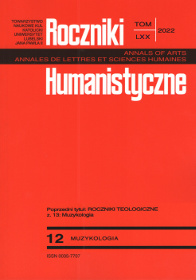Musical Otherwordly Beings: Cultural Transformations of Ritual Anti-Music and Anti-Instruments
Abstract
This article refers to the notions of otherworldly beings, both good and bad, playing on various musical instruments, which have been a significant part of European culture from the Middle Ages through to the present day. This phenomenon of a ritual uproar has been long documented in folk culture, mainly from the 19th century, performed on so-called anti-instruments and termed anti-music.
Nowadays in Kashubia, in the era of stage folklore, the old ritual anti-instruments, i.e. the devil’s violin and burczybas, have become percussion instruments in Kashubian folk bands. They play an additional, or perhaps a basic, function, as a sign of the regional identity of the Kashubians. The subject of music-making supernatural beings has also become fashionable in contemporary folk art in Poland. Music-making angels are often presented, but devils too, with various instruments, including folk ones. The disappearance of the traditional belief in the folk metaphysical vision of the world has made it possible to “equip” devils with those anti-instruments that had long been a human weapon against them. In folk art, images of this kind took on a grotesque character.
References
Aengenvoort, Johannes. „Musikgeschichtliche Einordnung der Instrumente des Engelchores”. Karl Johannes Heyer. Das barocke Chorgestühl in Schlesien. Eine Darstellung der Chorgestühle und ein Beitrag zur Geschichte von Kunst und Kunsthandwerk im Barock. Weidlich Verlag, 1977, ss. 139-144.
Baranowski, Bogdan. Najdawniejsze procesy o czary w Kaliszu. Polskie Towarzystwo Ludoznawcze, 1951.
Buchner, Alexander. Musikinstrumente von den Anfängen bis zur Gegenwart. Artia, 1971.
Habenicht, Gottfried. „Die rumänischen Sackpfeifen”. Jahrbuch für Volksliedforschung, t. 19, ss. 117-150.
Heise, Birgit. „Darstellungen musizierender Engel in und an mitteldeutschen Kirchen vom 14. bis zum 16. Jahrhundert”. Ikonographische Zeugnisse zu Musikinstrumenten in Mitteleuropa, t. 18, red. Günter Fleischhauer, Monika Lustig, Wolfgang Ruf i Frieder Zschoch. Stifung Kloster Michaelstein, 2000, ss. 73-88.
Nowak, Romuald. „«Orkiestra anielska» w rzeźbie śląskiej XVII i XVIII wieku”. Musica sacra. Motywy muzyczne w sztuce śląskiej XIII-XVIII w., katalog wystawy, red. Maria Zduniak, Romuald Nowak, Aniela Kolbuszewska i Alicja Knast, Muzeum Narodowe we Wrocławiu, 1997, ss. 26-71.
Parandowski, Jan. Mitologia: wierzenia i podania Greków i Rzymian. Czytelnik, 1965.
Przerembski, Zbigniew Jerzy. „Antymuzyka i antyinstrumenty w tradycji kulturowej Polski”. Muzyka, nr 2, 2021, ss. 121-140.
Przerembski, Zbigniew Jerzy. Dudy: dzieje instrumentu w kulturze staropolskiej. Instytut Sztuki PAN, 2006.
Przerembski, Zbigniew Jerzy. Dudy: instrument mało znany polskim ludoznawcom. Instytut Sztuki PAN, Towarzystwo Naukowe Warszawskie, 2007.
Przerembski Zbigniew Jerzy. Dudy: metamorfozy instrumentu w odrodzonej Polsce. Wydawnictwo Uniwersytetu Wrocławskiego 2020.
Przerembski Zbigniew Jerzy. „Postać muzykanta w polskiej sztuce ludowej – od uogólnienia do «studium przypadku»”. Kulturowe wymiary pogranicza, red. Bożena Lewandowska, Zakopiańskie Centrum Kultury, 2016, ss. 46-64.
Saban, Laryssa „«Dudki» na Huculszczynie”. VI Conferentia Investigatorum Musicae Popularis Russiae Rubrae Regionumque Finitimarum. Materiały, red. Bohdan Łukaniuk, Ministerstwo Kultury ta Mystectw Ukrajiny; Wyszczyj muzycznyj instytut im. M. Lysenka u Lwowi, Kafedra muzycznoji folkłorystyky, Naukowodoslidna łaboratorija muzycznoji etnołogiji; Lwiwśka orhanizacija spiłki kompozytoriw Ukrajiny. Folkłorystyczna komisija, 1955, ss. 43- 53.
Salmen, Walter, i Gabriele. Bilder zur Musikgeschichte Ostmitteleuropas. Bärenreiter, 1992.
Scombor, Márton. Mártona Scombora podróż do Gdańska. Tłumaczył Jan Ślaski. Oficyna Gdańska, 2012.
Schmidt, Ernst Eugen. Sackpfeifen in Schwaben. Die Wiederentdeckung eines vergessenen Volksmusikinstruments, mit Beiträgen von Georg Balling, Fritz Schneider, Manfred Stingel. Schwäbisches Kulturarchiv des Schwäbischen Albvereins; Verlag des Schwäbischen Albvereins, 1997.
Tammen, Björn R. „Engel unter Mönchen. Das Chorgestühl der Klosterkirche St. Godehard in Hildesheim (1466)”. Ikonographische Zeugnisse zu Musikinstrumenten in Mitteleuropa, t. 18, red. Günter Fleischhauer, Monika Lustig, Wolfgang Ruf i Frieder Zschoch. Stifung Kloster Michaelstein, 2000, ss. 59-72.
Thibout, Marc. „Le concert d’anges de la chapelle du Château de La Clayette”. La Revue des arts, t. 3, 1953, ss. 135-140.
Worzała, Elwira. Józef Semmerling – Rzeźbiarz z Krokowskiej Ziemi. Krokowa 2017.
Zíbrt, Čeněk. Jak se kdy v Čechách tancovalo. Dějiny tance v Čechách, na Moravě, ve Slezsku a na Slovensku od nejstarši doby až do konce 19. století se zvláštním zřetelem k dějinam tance vůbec. F. Šimáček, 1895.
Copyright (c) 2022 Roczniki Humanistyczne

This work is licensed under a Creative Commons Attribution-NonCommercial-NoDerivatives 4.0 International License.





